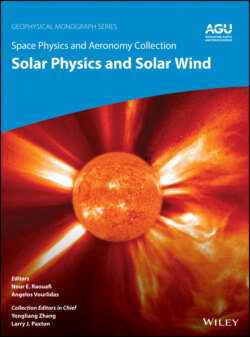Читать книгу Space Physics and Aeronomy, Solar Physics and Solar Wind - Группа авторов - Страница 15
1.2.2. Transient Coronal Outflows in the Nascent Solar Wind
ОглавлениеThe formation of the background solar wind, introduced in the previous section, is continually perturbed by the ejection of jets and small transients that form in the corona. Direct observations of these transient outflows in EUV and white‐light images by the STEREO and SoHO spacecraft have provided new insights on the origin of mesoscale structures measured in situ in the solar wind.
Variable solar wind outflows in the form of plasmoids are continually released from helmet streamers in white‐light (i.e., electron density) observations (e.g., Harrison et al., 2009; Rouillard, Davies, et al., 2010; Rouillard, Lavraud, et al., 2010; Rouillard et al., 2009; Sheeley et al., 1997; Sheeley et al., 2007; Wang et al., 1998; Wang et al., 2000). These plasmoids have been tracked from the corona, through the inner heliosphere, and in some cases out to 1 AU using heliospheric imagers (Rouillard, Davies, et al., 2010; Rouillard et al., 2011; Sheeley & Rouillard, 2010), showing in a direct way that some of the helmet streamer structures produced in the corona result in density structures measured in the inner heliosphere. Plasmoids (or “blobs”) have been tracked from the tip of streamers where they typically form to several tens of solar radii, and analysis of their kinematic properties has confirmed that they are advected in the slow wind (Sheeley et al., 1997). In fact, this type of analysis has provided one of the rare kinematic measurements of the forming slow wind. It has revealed that a subset of the slow solar wind is released right above helmet streamers and accelerates over 20–30 solar radii to reach its terminal speed of about 300 km/s (this acceleration is shown as the gray area in Figure 1.2).
Helmet streamers form in the corona where magnetic fields of opposite polarity meet, and therefore a complex reconfiguration of the solar magnetic field is likely to occur due to magnetic reconnection. Magnetic reconnection can occur high up in the solar atmosphere (4–6 solar radii), and the collapse of newly formed magnetic loops can force the downward motion of coronal plasma. When densities are high enough, these plasma “inflows” are detected in coronagraphs in the vicinity of streamers and the coronal neutral line where the heliospheric current sheet (described next) forms (Wang et al., 2000). Multispacecraft studies using SoHO and STEREO images have recently shown that these inflows are associated with the release of density blobs in the slow solar wind (Sanchez‐Diaz et al., 2017).
Figure 1.4 Propagating brightness fluctuations (green/black) derived from COR‐2 observations during a dedicated deep‐field campaign. The fluctuations are present at all azimuths and times, with a wide range of brightnesses and lateral sizes. The fluctuations appear with smaller scales than the Sheeley blobs (discussed in the text); such a blob is observed off the north‐western limb in this image as the larger bright green feature.
(Source: Taken from DeForest et al., 2018.)
An important property of density blobs and plasmoids released in the solar wind is their multi‐scale and cyclic nature. Fourier analysis of brightness variations released from a highly tilted current sheet near solar maximum has shown that the large plasmoids are released from the Sun with characteristic time scales of about 19–20 hr (Sanchez‐Diaz et al., 2017). Similar spectral analysis has revealed characteristic 90 min timescales embedded within the larger plasmoids (Kepko et al., 2016; Viall et al., 2010; Viall & Vourlidas, 2015). DeForest et al. (2018) used deep‐field, high‐cadence coronagraph observations to show that there is still more substructure (shown in Figure 1.4)—both time dynamic on scales smaller than 90 min, and time stationary, filamentary streamer structures down to the resolution limit. The time‐dynamic characteristic scale sizes likely have different formation causes, such as inherent time scales due to the characteristics of coronal heating (Endeve et al., 2004), or waves (Pylaev et al., 2017).
Observations of the corona therefore show that highly dynamic streamers host transient processes associated with the likely continual emergence, redistribution, and removal of solar magnetic flux directly influencing the properties of the magnetic fields and particles of the solar wind (Owens et al., 2013; Sanchez‐Diaz et al., 2016). Magnetic reconnection occurring at the boundary of coronal holes was suggested to occur in the 1980s to explain the rigid rotation of coronal holes (Wang et al., 1988). Theoretical considerations (Fisk, 1996) and sophisticated numerical MHD simulations have highlighted the inevitable, complex evolution that takes place all along the corona’s open‐closed field boundaries (Antiochos et al., 2007; Linker et al., 2011; Lionello et al., 2005; Titov et al., 2009; Titov et al., 2011). The activity hosted by helmet streamers are the clearest example, with many different scales of plasma and magnetic field signatures generated by magnetic reconnection (Higginson et al., 2017; Higginson & Lynch, 2018; Lionello et al., 2005; Török et al., 2009).
Heliospheric imaging has also shown that not all structures at MHD scales measured in the solar wind form in the corona. DeForest, Matthaeus, Viall, and Cranmer (2016) showed turbulent density fluctuations setting in around 30 solar radii away from the Sun. These fluctuations coexist with outflowing helmet streamer plasmoids and are advected with the solar wind.
